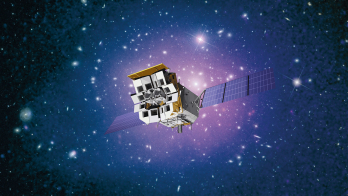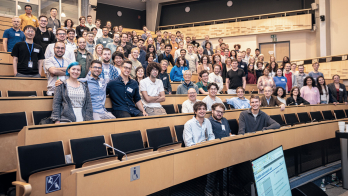A newly endorsed ground-based observatory to study the anisotropies in the cosmic microwave background (CMB) will deliver transformative discoveries in fundamental physics, cosmology, astrophysics and astronomy, writes Julian Borrill.
To address the major questions in cosmology, the cosmic microwave background (CMB) remains the single most important phenomenon that can be observed. Not this author’s words, but those of the recent US National Academies of Sciences, Engineering, and Medicine report Pathways to Discovery in Astronomy and Astrophysics for the 2020s (Astro2020), which recommended that the US pursue a next-generation ground-based CMB experiment, CMB-S4, to enter operation in around 2030.
The CMB comprises the photons created in the Big Bang. These photons have therefore experienced the entire history of the universe. Everything that has happened has left an imprint on them in the form of anisotropies in their temperature and polarisation with characteristic amplitudes and angular scales. The early universe was hot enough to be completely ionised, which meant that the CMB photons constantly scattered off free electrons. During this period the primary CMB anisotropies were imprinted, tracing the overall geometry of the universe, the fraction of the energy density in baryons, the number of light-relic particles and the nature of inflation. After about 375,000 years of expansion the universe cooled enough for neutral hydrogen atoms to be stable. With the free electrons rapidly swept up by protons, the CMB photons simply free-streamed in whatever direction they were last moving in. When we observe the CMB today we therefore see a snapshot of this so-called last-scattering surface.
The continued evolution of the universe had two main effects on the CMB photons. First, its ongoing expansion stretched their wavelengths to peak at microwave frequencies today. Second, the growth of structure eventually formed galaxy clusters that changed the direction, energy and polarisation of the CMB photons that pass through them, both from gravitational lensing by their mass and from inverse Compton scattering by the hot gas that makes up the inter-cluster medium. These secondary anisotropies therefore constrain all of the parameters that this history depends on, from the moment the first stars formed to the number of light-relic particles and the masses of neutrinos.
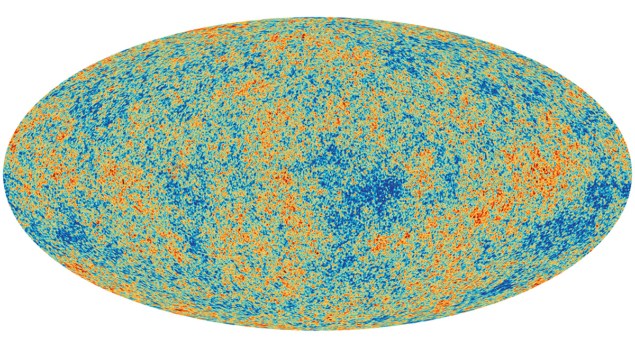
As noted by the Astro2020 report, the history of CMB research is that of continuously improving ground and balloon experiments, punctuated by comprehensive measurements from the major satellite missions COBE, WMAP and Planck. The increasing temperature and polarisation sensitivity and angular resolution of these satellites is evidenced in the depth and resolution of the maps they produced (see “Relic radiation” image”). However, such maps are just our view of the CMB – one particular realisation of a random process. To derive the underlying cosmology that gave rise to them, we need to measure the amplitude of the anisotropies on various angular scales (see “Power spectra” figure). Following the serendipitous discovery of the CMB in 1965, the first measurements of the temperature anisotropy were made by COBE in 1992. The first peak in the temperature power spectrum was measured by the BOOMERanG and MAXIMA balloons in 2000, followed by the E-mode polarisation of the CMB by the DASI experiment in 2002, and the B-mode polarisation by the South Pole Telescope and POLARBEAR experiments in 2015.
CMB-S4, a joint effort supported by the US Department of Energy (DOE) and the National Science Foundation (NSF), will help write the next chapter in this fascinating adventure. Planned to comprise 21 telescopes at the South Pole and in the Chilean Atacama Desert instrumented with more than 500,000 cryogenically-cooled superconducting detectors, it will exceed the capabilities of earlier generations of experiments by more than an order of magnitude and deliver transformative discoveries in fundamental physics, cosmology, astrophysics and astronomy.
The CMB-S4 challenge
Three major challenges must be addressed to study the CMB at such levels of precision. Firstly, the signals are extraordinarily faint, requiring massive datasets to reduce the statistical uncertainties. Secondly, we have to contend with systematic effects both from imperfect instruments and from the environment, which must be controlled to exquisite precision if they are not to swamp the signals. Finally, the signals are obscured by other sources of microwave emission, especially galactic synchrotron and dust emission. Unlike the CMB, these sources do not have a black-body spectrum, so it is possible to distinguish between CMB and non-CMB sources if observations are made at enough microwave frequencies to break the degeneracy.

This third challenge actually proves to be an astrophysical blessing as well as a cosmological curse: CMB observations are also excellent legacy surveys of the millimetre-wave sky, which can be used for a host of other science goals. These range from cataloguing galaxy clusters, to studying the Milky Way, to detecting spatial and temporal transients such as gamma-ray bursts via their afterglows.
Coming together
In 2013 the US CMB community came together in the Snowmass planning process, which informs the deliberations of the decadal Particle Physics Project Prioritization Panel (P5). We realised that achieving the sensitivity needed to make the next leap in CMB science would require an experiment of such magnitude (and therefore cost) that it could only be accomplished as a community-wide endeavour, and that we would therefore need to transition from multiple competing experiments to a single collaborative one. By analogy with the US dark-energy programme, this was designated a “Stage 4” experiment, and hence became known as CMB-S4.
In 2014 a P5 report made the critical recommendation that the DOE should support CMB science as a core piece of its programme. The following year a National Academies report identified CMB science as one of three strategic priorities for the NSF Office of Polar Programs. In 2017 the DOE, NSF and NASA established a task force to develop a conceptual design for CMB-S4, and in 2019 the DOE took “Critical Decision 0”, identifying the mission need and initiating the CMB-S4 construction project. In 2020 Berkeley Lab was appointed the lead laboratory for the project, with Argonne, Fermilab and SLAC all playing key roles. Finally, late last year, the long-awaited Astro2020 report unconditionally recommended CMB-S4 as a joint NSF and DOE project with an estimated cost of $650 million. With these recommendations in place, the CMB-S4 construction project could begin.
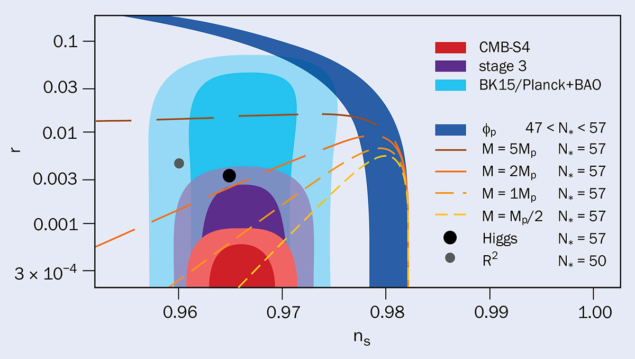
From the outset, CMB-S4 was intended to be the first sub-orbital CMB experiment designed to reach specific critical scientific thresholds, rather than simply to maximise the science return under a particular cost cap. Furthermore, as a community-wide collaboration, CMB-S4 will be able to adopt and adapt the best of all previous experiments’ technologies and methodologies – including operating at the site best suited to each science goal. One third of the major questions and discovery areas identified across the six Astro2020 science panels depend on CMB observations.
The critical degrees of freedom in the design of any observation are the sky area, frequency coverage, frequency-dependent depth and angular resolution, and observing cadence. Having reviewed the requirements across the gamut of CMB science, four driving science goals have been identified for CMB-S4.
For the first time, the entire community is coming together to build an experiment defined by achieving critical science thresholds
The first is to test models of inflation via the primordial gravitational waves they naturally generate. Such gravitational waves are the only known source of a primordial B-mode polarisation signal. The size of these primordial B-modes is quantified by the ratio of their power to that of the temperature power spectrum – the scalar-to-tensor ratio, designated r. For the largest and most popular classes of inflationary models, CMB-S4 will make a 5σ detection of r, while failure to make such a measurement will put an upper limit of r ≤ 0.001 at 95% confidence, setting a rigorous constraint on alternative models (see “Constraining inflation” figure). The large-scale B-mode polarisation signal encoding r is the faintest of all the CMB signals, requiring both the deepest measurement and the widest low-resolution frequency coverage of any CMB-S4 science case.
The second goal concerns the dark universe. Dark matter and dark energy make up 95% of the universe’s mass-energy content, and their particular form and composition impact the growth of structure and thus the small-scale CMB anisotropies. The collective influence of the three known light-relic particles (the Standard Model neutrinos) has already been observed in CMB data, but many new light species, such as axion-like particles and sterile neutrinos, are predicted by extensions of the Standard Model. CMB-S4’s goal, and the most challenging measurement in this arena, is to detect any additional light-relic species with freeze-out temperatures up to the QCD phase-transition scale. This corresponds to constraining the uncertainty on the number of light-relic species Neff to ≤ 0.06 at 95% confidence (see “Light relics” figure). Precise measurements of the small-scale temperature and E-mode polarisation signals that encode this signal require the largest sky area of any CMB-S4 science case. In addition, since the sum of the masses of the neutrinos impacts the degree of lensing of the E-mode polarisation into small-scale B-modes, CMB-S4 will be able to constrain this sum around a fiducial value of 58 meV with a 1σ uncertainty ≤ 24 meV (in conjunction with baryon acoustic oscillation measurements) and ≤ 14 meV with better measurements of the optical depth to reionisation.
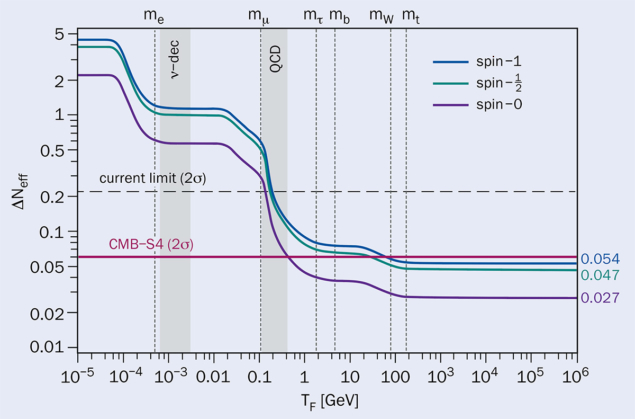
The third science goal is to understand the formation and evolution of galaxy clusters, and in particular to probe the early period of galaxy formation at redshifts z > 2. This is enabled by the Sunyaev–Zel’dovitch (SZ) effect, whereby CMB photons are up-scattered by the hot, moving gas in the intra-cluster medium. This shifts the CMB photons’ frequency spectrum, resulting in a decrement at frequencies below 217 GHz and an increment at frequencies above, therefore allowing clusters to be identified by matching up the corresponding cold and hot spots. A key feature of the SZ effect is its red-shift independence, allowing us to generate complete, flux-limited catalogues of clusters to the survey sensitivity. The small-scale temperature signals needed for such a catalogue require the highest angular resolution and the widest high-resolution frequency coverage of all the CMB-S4 science cases.
Finally, CMB-S4 aims to explore the mm-wave transient sky, in particular the rate of gamma-ray bursts to help constrain their mechanisms (a few hours to days after the initial event, gamma-ray bursts are observable at longer wavelengths). CMB-S4 will be so sensitive that even its daily maps will be deep enough to detect mm-wave transient phenomena – either spatial from nearby objects moving across our field, or temporal from distant objects exploding in our field. This is the only science goal that places constraints on the survey cadence, specifically on the lag between repeated observations of the same point on the sky. Given its large field of view, CMB-S4 will be an excellent tool for serendipitous discovery of transients but less useful for follow-up observations. The plan is therefore to issue daily alerts for other teams to follow up with targeted observations.
Survey design
While it would be possible to meet all of the CMB-S4 science goals with a single survey, the result – requiring the sensitivity of the inflation survey across the area of the light-relic survey – would be prohibitively expensive. Instead, the requirements have been decoupled into an ultra-deep, small-area survey to meet the inflation goal and a deep, wide-area survey to meet the light-relic goal, the union of these providing a two-tier “wedding cake” survey for the cluster and gamma-ray-burst goals.
Having set the survey requirements, the task was to identify sites at which these observations can most efficiently be made, taking into account the associated cost, schedule and risk. Water vapour is a significant source of noise at microwave frequencies, so the first requirement on any site is that it be high and dry. A handful of locations meet this requirement, and two of them – the South Pole and the high Chilean Atacama Desert – have both exceptional atmospheric conditions and long-standing US CMB programmes. Their positions on Earth also make them ideally suited to CMB-S4’s two-survey strategy: the polar location enables us to observe a small patch of sky continuously, minimising the time needed to reach the required observation depth, and the more equatorial Chilean location enables observations over a large sky area.
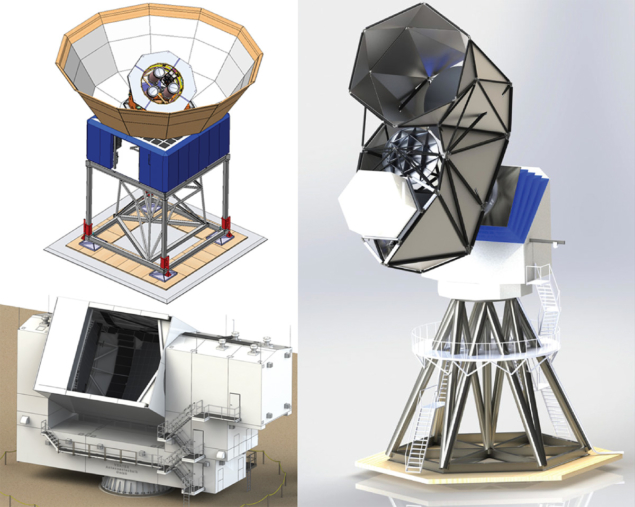
Finally, we know that instrumental systematics will be the limiting factor in resolving the extraordinarily faint large-scale B-mode signal. To date, the experiments that have shown the best control of such systematics have used relatively small-aperture (~0.5 m) telescopes. However, the secondary lensing of the much brighter E-mode signal to B-modes, while enabling us to measure the neutrino-mass sum, also obscures the primordial B-mode signal coming from inflation. We therefore need a detailed measurement of this medium- to small-scale lensing signal in order to be able to remove it at the necessary precision. This requires larger, higher-resolution telescopes. The ultra-deep field is therefore itself composed of coincident low- and high-resolution surveys.
A key feature of CMB-S4 is that all of the technologies are already well-proven by the ongoing Stage 3 experiments. These include CMB-S4’s “founding four” experiments, the Atacama Cosmology Telescope (ACT) and POLARBEAR/Simons Array (PB/SA) in Chile, and BICEP/Keck (BK) and the South Pole Telescope (SPT) at the South Pole, which have pairwise-merged into the Simons and South Pole Observatories (SO and SPO). The ACT, PB/SA, BK and SPT are all single-aperture, single-site experiments, while SO and SPO are dual-aperture, single sites. CMB-S4 is therefore the first experiment able to take advantage of both apertures and both sites.
The key difference with CMB-S4 is that it will deploy these technologies on an unprecedented scale. As a result, the primary challenges for CMB-S4 are engineering ones, both in fabricating detector and readout modules in huge numbers and in deploying them in cryostats on telescopes with unprecedented systematics control. The observatory will comprise: 18 small-aperture refractors collectively fielding about 150,000 detectors across eight frequencies for measuring large angular scales; one large-aperture reflector with about 130,000 detectors across seven frequencies for measuring medium-to-small angular scales in the ultra-deep survey from the South Pole; and two large-aperture reflectors collectively fielding about 275,000 detectors across six frequencies for measuring medium-to-small angular scales in the wide-deep survey from Chile (see “Looking up” image). The final configuration maximises the use of available atmospheric windows to control for microwave foregrounds (particularly synchrotron and dust emission at low and high frequencies, respectively), and to meet the frequency-dependent depth and angular-resolution requirements of the surveys.
CMB-S4 will be able to adopt and adapt the best of all previous experiments’ technologies and methodologies
Covering the frequency range 20–280 GHz, the detectors employ dichroic pixels at all but one frequency (to maximise the use of the available focal plane) using superconducting transition-edge sensors, which have become the standard in the field. A major effort is already underway to scale up the production and reduce the fabrication variance of the detectors, taking advantage of the DOE national laboratories and industrial partners. Reading out such large numbers of detectors with limited power is a significant challenge, leading CMB-S4 to adopt the conservative but well-proven time-domain multiplexing approach. The detector and readout systems will be assembled into modules that will be cryogenically cooled to 100 mK to reduce instrument noise. Each large-aperture telescope will carry an 85-tube cryostat with a single wafer per optics tube; and each small-aperture telescope will carry a single optics tube with 12 wafers per tube, with three telescopes sharing a common mount.
Prototyping of detector and readout fabrication lines, and building up module assembly and testing capabilities, is expected to begin in earnest this year. At the same time, the telescope designs will be refined and the data acquisition and management subsystems developed. The current schedule sees a staggered commissioning of the telescopes in 2028–2030, and operations running for seven years thereafter.
Shifting paradigms
CMB-S4 represents a paradigm shift for sub-orbital CMB experiments. For the first time, the entire community is coming together to build an experiment defined by achieving critical science thresholds in fundamental physics, cosmology, astrophysics and astronomy, rather than by its cost cap. CMB-S4 will span the entire range of CMB science in a single experiment, take advantage of the best of all worlds in the design of its observation and instrumentation, and make the results available to the entire CMB community. As an extremely sensitive, two-tiered, multi-wavelength, mm-wave survey, it will also play a key role in multi-messenger astrophysics and transient science. Taken together, these measurements will constitute a giant leap in our study of the history of the universe.







